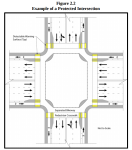Caltrans issues design guidance for awesome protected bikeways to redesign our cities

Last week California’s Transportation Agency, Caltrans, issued a Design Guidance document describing implementation of protected bikeways in California. The document should make it easier for California cities to design/redesign their cities to provide a better balance between all street system users. The picture shown above is one of the…

















